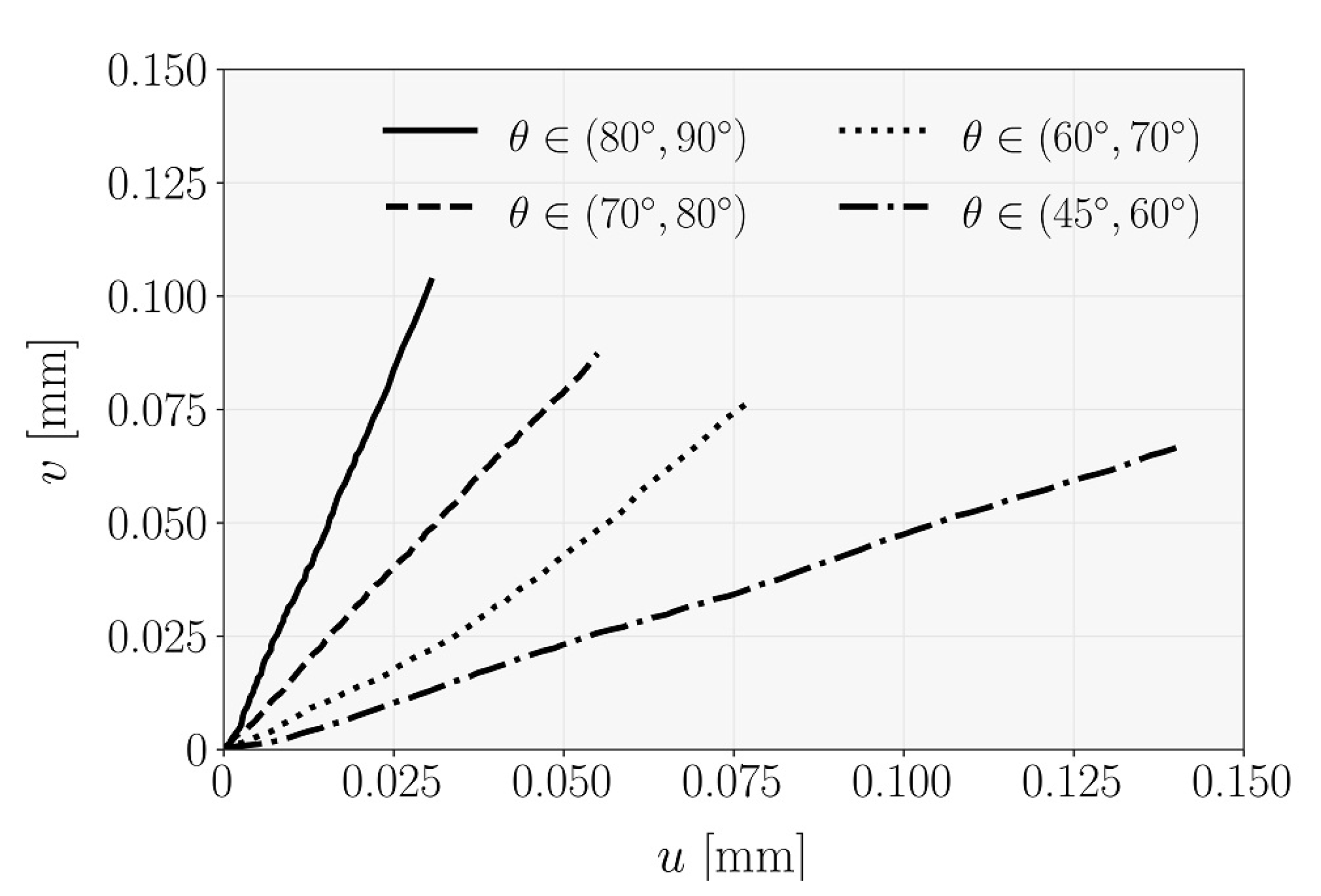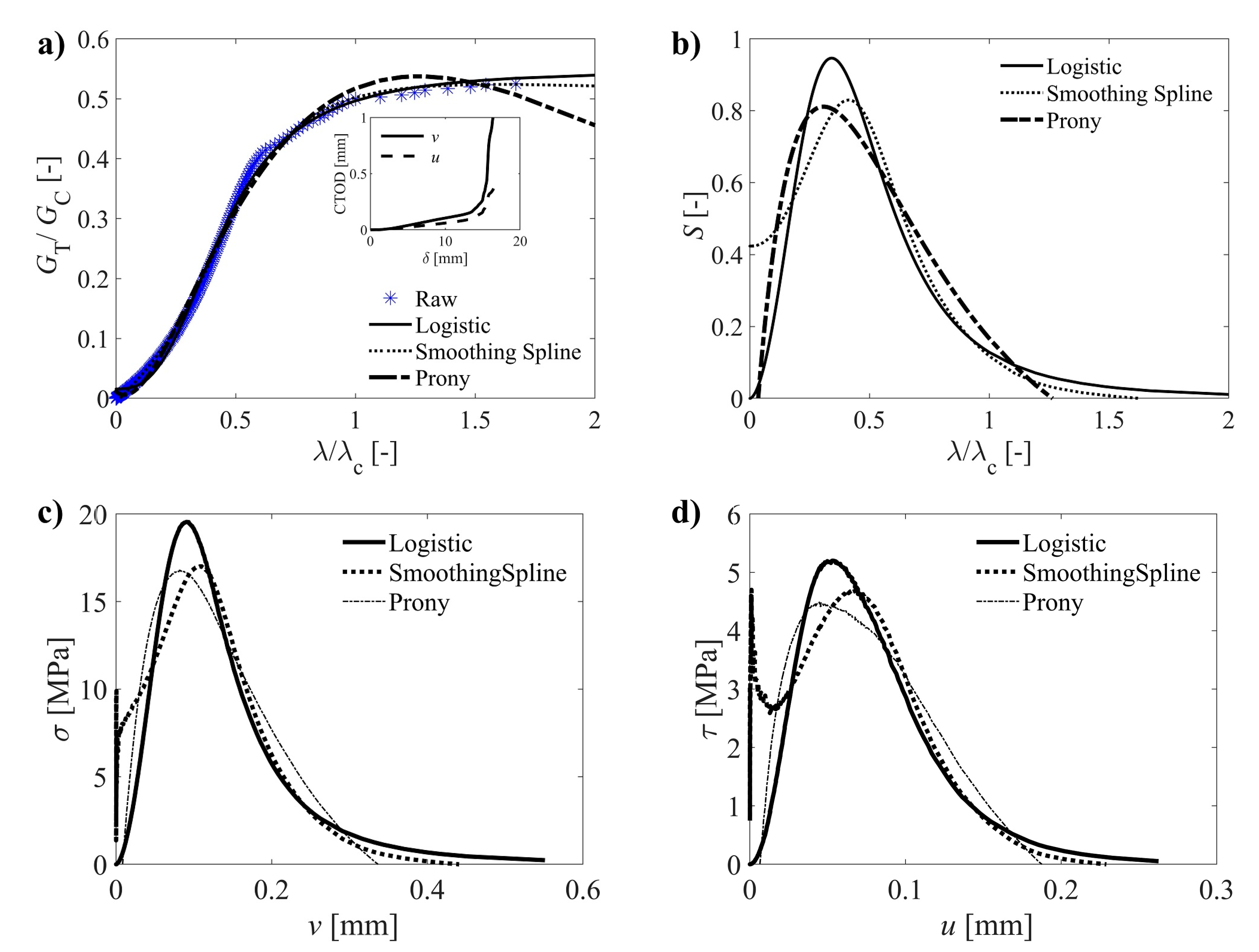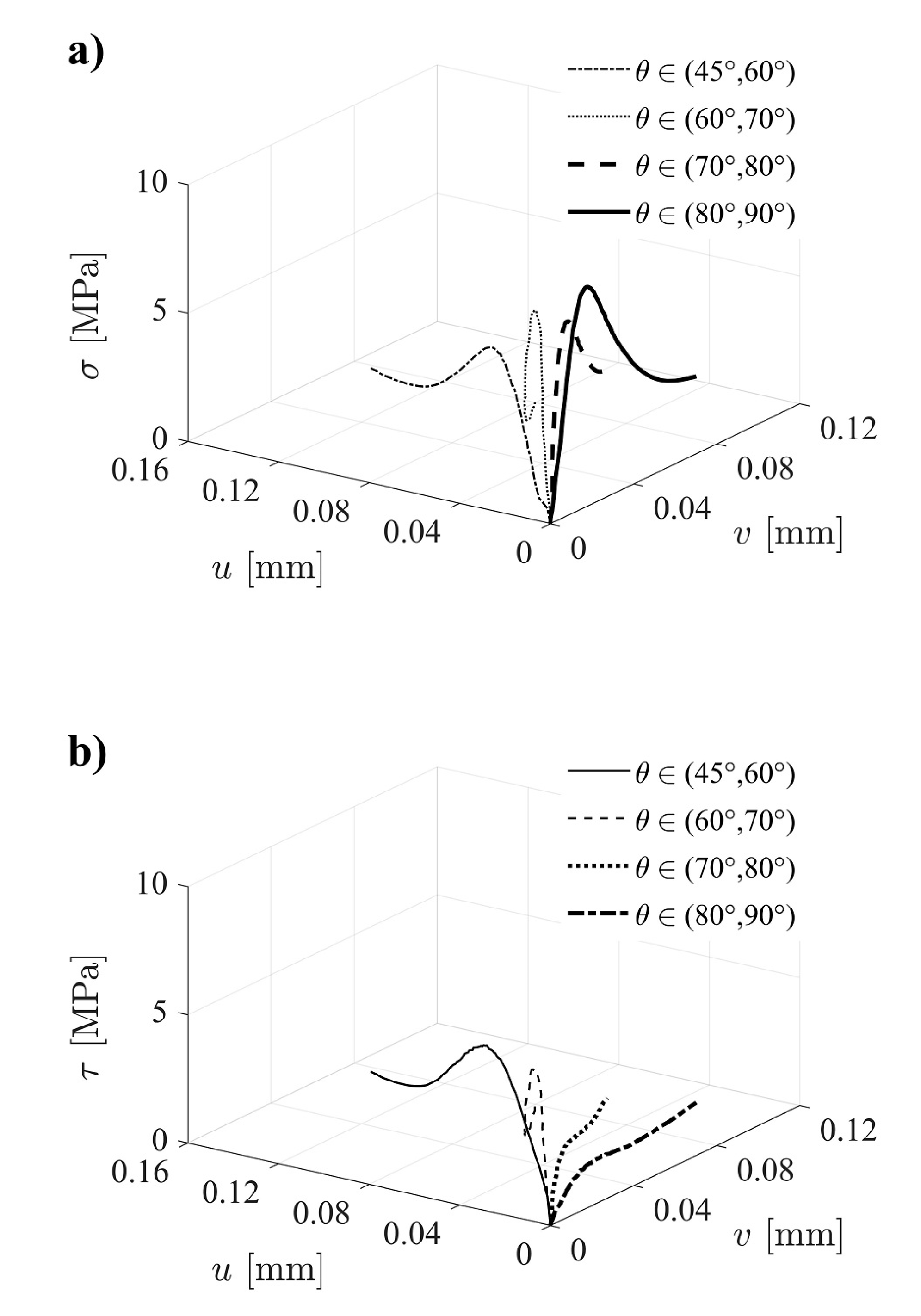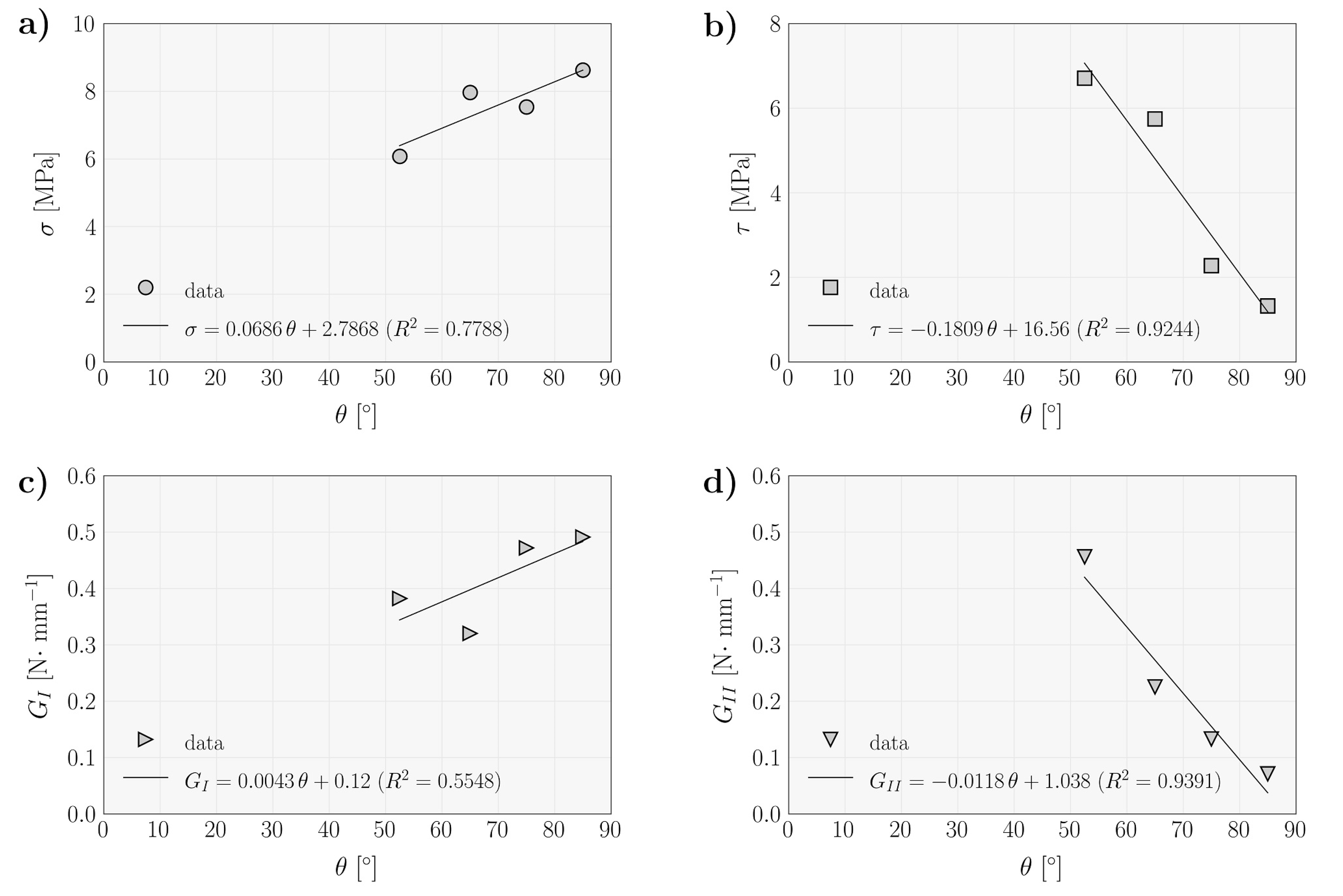Direct Evaluation of Mixed Mode I+II Cohesive Laws of Wood by Coupling MMB Test with DIC
Abstract
:1. Introduction
2. Materials and Methods
2.1. Mixed mode Bending (MMB) Test
2.2. Evaluation of Cohesive Law
3. Experimental Work
3.1. Material and Specimens
3.2. Full-Field Deformation Measurements by DIC
3.3. MMB Fracture Tests
4. Results and Discussion
5. Conclusions
Author Contributions
Funding

Data Availability Statement
Conflicts of Interest
References
- Reiterer, A.; Sinn, G.; Stanzl-Tschegg, S.E. Fracture characteristics of different wood species under mode I loading perpendicular to the grain. Mater. Sci. Eng. A 2002, 332, 29–36. [Google Scholar] [CrossRef]
- Yoshihara, H.; Ohta, M. Measurement of mode II fracture toughness of wood by the end-notched flexure test. J. Wood Sci. 2000, 46, 273–278. [Google Scholar] [CrossRef]
- De Moura, M.F.S.F.; Morais, J.J.L.; Dourado, N. A new data reduction scheme for mode I wood fracture characterization using the DCB test. Eng. Fract. Mech. 2008, 75, 3852–3865. [Google Scholar] [CrossRef]
- De Moura, M.F.S.F.; Silva, M.A.L.; de Morais, A.B.; Morais, J.J.L. Equivalent crack based mode II fracture characterization of wood. Eng. Fract. Mech. 2006, 73, 978–993. [Google Scholar] [CrossRef]
- Xavier, J.; Oliveira, J.; Monteiro, P.; Morais, J.J.L.; de Moura, M.F.S.F. Direct evaluation of cohesive law in mode I of Pinus pinaster by digital image correlation. Exp. Mech. 2014, 54, 829–840. [Google Scholar] [CrossRef]
- Xavier, J.; Oliveira, M.; Morais, J.; de Moura, M.F.S.F. Determining mode II cohesive law of Pinus pinaster by combining the end-notched flexure test with digital image correlation. Constr. Build. Mater. 2014, 71, 109–115. [Google Scholar] [CrossRef]
- Jernkvist, L.O. Fracture of wood under mixed-mode loading II. Experimental investigation of Pices abies. Eng. Fract. Mech. 2001, 68, 565–576. [Google Scholar] [CrossRef]
- Tschegg, E.K.; Reiterer, A.; Pleschbergers, T.; Stanzl-Tschegg, E. Mixed mode fracture energy of spruce wood. J. Mater. Sci. 2001, 36, 3531–3537. [Google Scholar] [CrossRef]
- Reeder, J.R.; Crews, J.H., Jr. Mixed-mode bending method for delamination testing. AIAA J. 1990, 28, 1270–1276. [Google Scholar] [CrossRef] [Green Version]
- Crews, J.H.; Reeder, J.R. A Mixed-Mode Bending Apparatus for Delamination Testing; NASA Technical Memorandum 100662; National Aeronautics and Space Administration, Langley Research Center: Hampton, VA, USA, 1988.
- Reeder, J.; Crews, J. Redesign of the Mixed-Mode Bending Delamination Test to Reduce Nonlinear Effects. ASTM J. Compos. Technol. Res. 1992, 14, 12–19. [Google Scholar]
- Chen, J.H.; Sernow, R.; Schulz, E.; Hinrichsen, G.A. modification of the mixed-mode bending test apparatus. Compos. Part A Appl. Sci. 1999, 30, 871–877. [Google Scholar] [CrossRef]
- ASTM D6671/D6671M-19. Standard Test Method for Mixed Mode I-Mode II Interlaminar Fracture Toughness of Unidirectional Fiber Reinforced Polymer Matrix Composites; ASTM International: West Conshohocken, PA, USA, 2019. [Google Scholar]
- De Moura, M.F.S.F.; Oliveira, J.M.Q.; Morais, J.J.L.; Xavier, J. Mixed-mode I/II wood fracture characterization using the mixed-mode bending test. Eng. Fract. Mech. 2010, 77, 144–152. [Google Scholar] [CrossRef]
- De Moura, M.F.S.F.; Oliveira, J.M.Q.; Morais, J.J.L.; Dourado, N. Mixed-mode (I+II) fracture characterization of wood bonded joints. Constr. Build. Mater. 2011, 25, 1956–1962. [Google Scholar] [CrossRef]
- Grédiac, M.; Hild, F. (Eds.) Full-Field Measurements and Identification in Solid Mechanics; John Wiley and Sons: Hoboken, NJ, USA, 2012. [Google Scholar]
- Pereira, J.; Xavier, J.; Morais, J.; Lousada, J. Assessing wood quality by spatial variation of elastic properties within the stem: Case study of P. pinaster in the transverse plane. Can. J. For. Res. 2014, 44, 1–11. [Google Scholar] [CrossRef]
- Pereira, J.L.; Xavier, J.; Ghiassi, B.; Lousada, J.; Morais, J. On the identification of earlywood and latewood radial elastic modulus of P. pinaster by digital image correlation: A parametric analysis. J. Strain Anal. Eng. 2018, 53, 566–574. [Google Scholar] [CrossRef]
- Catalanotti, G.; Camanho, P.P.; Xavier, J.; Dávila, C.G.; Marques, A.T. Measurement of resistance curves in the longitudinal failure of composites using digital image correlation. Compos. Sci. Technol. 2010, 70, 1986–1993. [Google Scholar] [CrossRef] [Green Version]
- Cappello, R.; Pitarresi, G.; Xavier, J.; Catalanotti, G. Experimental determination of mode I fracture parameters in orthotropic materials by means of Digital Image Correlation. Theor. Appl. Fract. Mec. 2020, 108, 102663. [Google Scholar] [CrossRef]
- Dias, G.F.; de Moura, M.F.S.F.; Chousal, J.A.G.; Xavier, J. Cohesive laws of composite bonded joints under mode I loading. Compos. Struct. 2013, 106, 646–652. [Google Scholar] [CrossRef]
- Fernandes, R.M.R.P.; Chousal, J.A.G.; de Moura, M.F.S.F.; Xavier, J. Determination of cohesive laws of composite bonded joints under mode II loading. Compos. Part B Eng. 2013, 52, 269–274. [Google Scholar] [CrossRef]
- Koerber, H.; Xavier, J.; Camanho, P.P. High strain rate characterisation of unidirectional carbon-epoxy IM7-8552 in transverse compression and in-plane shear using digital image correlation. Mech. Mater. 2010, 42, 1004–1019. [Google Scholar] [CrossRef]
- Catalanotti, G.; Kuhn, P.; Xavier, J.; Koerber, H. High strain rate characterisation of intralaminar fracture toughness of GFRPs for longitudinal tension and compression failure. Compos. Struct. 2020, 240, 112068. [Google Scholar] [CrossRef]
- Xavier, J.; Pereira, J.C.R.; de Jesus, A.M.P. Characterisation of steel components under monotonic loading by means of image-based methods. Opt. Lasers Eng. 2014, 53, 142–151. [Google Scholar] [CrossRef]
- Xavier, J.; Avril, S.; Pierron, F.; Morais, J. Novel experimental approach for longitudinal-radial stiffness characterisation of clear wood by a single test. Holzforschung 2007, 61, 573–581. [Google Scholar] [CrossRef]
- Xavier, J.; Pierron, F. Characterisation of orthotropic bending stiffness components of P. pinaster by the virtual fields method. J. Strain Anal. Eng. 2018, 53, 556–565. [Google Scholar] [CrossRef]
- Sutton, M.; Orteu, J.-J.; Schreier, H. Image Correlation for Shape, Motion and Deformation Measurements: Basic Concepts, Theory and Applications; Springer: Berlin/Heidelberg, Germany, 2009. [Google Scholar]
- Réthoré, J.; Hild, F.; Roux, S. Extended digital image correlation with crack shape optimization. Int. J. Numer. Meth. Eng. 2008, 732, 248–272. [Google Scholar] [CrossRef] [Green Version]
- Sousa, A.M.R.; Xavier, J.; Morais, J.J.L.; Filipe, V.M.J.; Vaz, M. Processing discontinuous displacement fields by a spatio-temporal derivative technique. Opt. Lasers Eng. 2011, 49, 1402–1412. [Google Scholar] [CrossRef]
- Sørensen, B.F.; Kirkegaard, P. Determination of Mixed Mode Cohesive Laws. Eng. Fract. Mech. 2006, 73, 2642–2661. [Google Scholar] [CrossRef]
- Högberg, J. Mixed mode cohesive law. Int. J. Fract. 2006, 141, 549–559. [Google Scholar] [CrossRef]
- Xavier, J.; de Jesus, A.M.P.; Morais, J.J.L.; Pinto, J.M.T. Stereovision measurements on evaluating the modulus of elasticity of wood by compression tests parallel to the grain. Constr. Build. Mater. 2012, 26, 207–215. [Google Scholar] [CrossRef]
- Hastie, T.J.; Tibshirani, R.J. Generalized Additive Models; Chapman and Hall: London, UK, 1990. [Google Scholar]
- De Moura, M.F.S.F.; Dourado, N. Mode I fracture characterization of wood using the TDCB test. Theor. Appl. Fract. Mec. 2018, 94, 40–45. [Google Scholar] [CrossRef]
- De Moura, M.F.S.F.; Silva, M.A.L.; Morais, J.J.L.; Dourado, N. Mode II fracture characterization of wood using the Four-Point End-Notched Flexure (4ENF) test. Theor. Appl. Fract. Mec. 2018, 98, 23–29. [Google Scholar] [CrossRef]
. |








Publisher’s Note: MDPI stays neutral with regard to jurisdictional claims in published maps and institutional affiliations. |
© 2021 by the authors. Licensee MDPI, Basel, Switzerland. This article is an open access article distributed under the terms and conditions of the Creative Commons Attribution (CC BY) license (http://creativecommons.org/licenses/by/4.0/).
Share and Cite
Oliveira, J.; Xavier, J.; Pereira, F.; Morais, J.; de Moura, M. Direct Evaluation of Mixed Mode I+II Cohesive Laws of Wood by Coupling MMB Test with DIC. Materials 2021, 14, 374. https://doi.org/10.3390/ma14020374
Oliveira J, Xavier J, Pereira F, Morais J, de Moura M. Direct Evaluation of Mixed Mode I+II Cohesive Laws of Wood by Coupling MMB Test with DIC. Materials. 2021; 14(2):374. https://doi.org/10.3390/ma14020374
Chicago/Turabian StyleOliveira, Jorge, José Xavier, Fábio Pereira, José Morais, and Marcelo de Moura. 2021. "Direct Evaluation of Mixed Mode I+II Cohesive Laws of Wood by Coupling MMB Test with DIC" Materials 14, no. 2: 374. https://doi.org/10.3390/ma14020374
APA StyleOliveira, J., Xavier, J., Pereira, F., Morais, J., & de Moura, M. (2021). Direct Evaluation of Mixed Mode I+II Cohesive Laws of Wood by Coupling MMB Test with DIC. Materials, 14(2), 374. https://doi.org/10.3390/ma14020374





